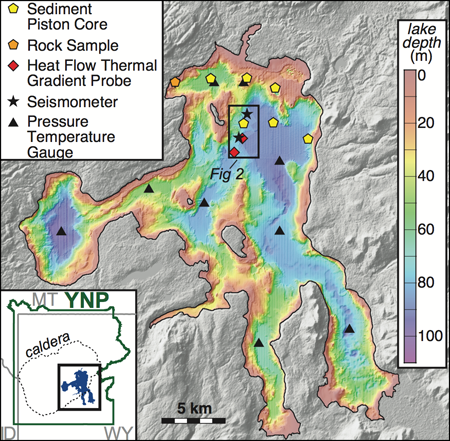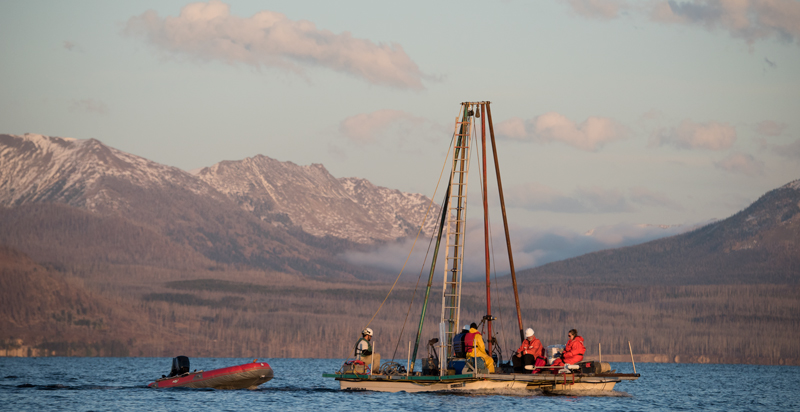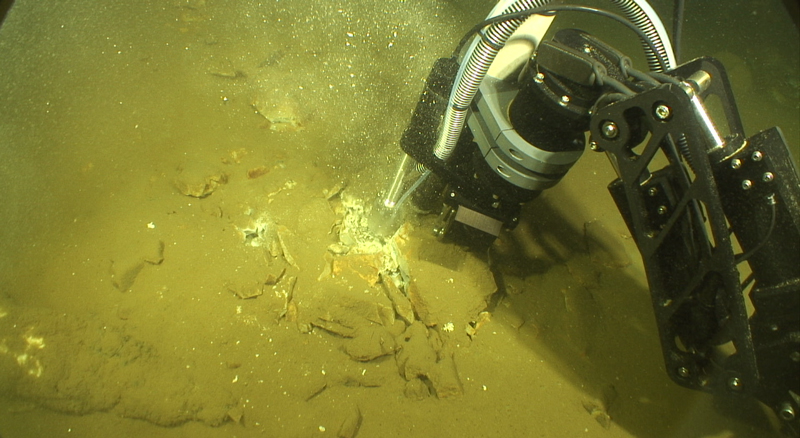Yellowstone Lake, the largest high-altitude freshwater lake in North America, covers some 341 square kilometers of Yellowstone National Park in northwestern Wyoming. Hot springs, geysers, and fumaroles in and around the lake serve as constant reminders of the volcanically and seismically active Yellowstone caldera below.
The vent fields on the floor of Yellowstone Lake are a significant part of the world’s largest continental hydrothermal system and thus form an important part of the Earth’s thermal budget and geochemical cycles. Continental hydrothermal systems are a primary source of economically important metal deposits, provide geothermal energy resources, support exotic ecosystems that are just beginning to be explored, and, in some settings such as Yellowstone, pose significant geological hazards.
Continental hydrothermal systems are typically located in dynamic geological environments where the rocks through which fluids flow are perturbed frequently. Understanding the cause-and-effect relationships between these perturbations and hydrothermal flow can yield valuable insights into subsurface processes that are otherwise difficult to observe [e.g., Manga et al., 2012; Wilcock, 2004].

Our team of researchers has embarked on a multiyear project to understand how the Yellowstone Lake hydrothermal system responds to geological and environmental forcing (Figure 1) [Morgan et al., 2003; Farrell et al., 2010]. Fieldwork for the Hydrothermal Dynamics of Yellowstone Lake (HD-YLAKE) project began in the summer of 2016 and will continue through 2018. The project has major funding and logistical support from the National Science Foundation, the Yellowstone Volcano Observatory, the U.S. Geological Survey, and the National Park Service.
A Not-So-Peaceful Alpine Lake
Yellowstone Lake is a large freshwater alpine lake that sits atop a vigorous hydrothermal system [Morgan et al., 1977]. This hydrothermal system is sensitive to such geological and environmental processes as lake-level fluctuations, wind-driven waves, earthquakes, solid Earth tides, and caldera deformation cycles. These processes affect the pressure that confines the lake floor vent fields and the temperatures and stresses acting on the subsurface materials through which fluids flow.
The number of large hydrothermal features in and around the northern part of the lake dramatically illustrates the area’s sensitivity to perturbations.
The northeastern part of the lake hosts large hydrothermal explosion craters, including the Mary Bay explosion crater, which, with a diameter of about 2.6 kilometers, is the largest documented such feature in the world [Morgan et al., 2009]. The number of large (>100 meters in diameter) hydrothermal features in and around the northern part of the lake dramatically illustrates the area’s sensitivity to perturbations. Hydrothermal explosion craters form when subsurface liquids flash to steam in response to a rapid pressure drop (which could occur in response to a sudden change in lake level caused by an earthquake inside the caldera, for example) and represent an extreme example of a cause-and-effect relationship between geological processes and the thermodynamic state of the hydrothermal fluids.
Our project seeks to understand these relationships by observing how the temperature and composition of the hydrothermal fluids, the heat flow of the system, and the microbial communities inhabiting the vent fields respond to forcing. Our field strategy uses a two-pronged approach: geophysical and geochemical monitoring of the active system and analyses of sediment cores to study the postglacial (~15,000-year) history of hydrothermal activity beneath the lake.

In 2016, we deployed a network of pressure-temperature gauges, heat flow equipment, and seismometers on the lake floor (Figures 1, 2, and 3). We collected sediment gravity cores from the top meter of the lake bed, sediment piston cores as long as 12.1 meters, gastight hydrothermal fluid samples, and samples of filamentous microbial material. In 2017, we began analyzing these data and samples; collected another set of samples and heat flow measurements; and deployed a full-scale network of monitoring instrumentation, including 10 lake bottom seismometers and two in situ chemical sensors, at the focus site (Figures 2 and 4). Monitoring equipment on the lake floor will be recovered in August 2018.
Sampling the Sediment Record

The HD-YLAKE project seeks to reconstruct the relationship between the long-term history of hydrothermal activity in Yellowstone Lake and its influence on limnological and climate-driven processes in the lake and its watershed. In 2016, using the National Lacustrine Core Facility’s (LacCore) Kullenberg corer, we collected eight sediment piston cores from six different geologic environments in the lake’s northern basin (Figure 1):
- an inactive hydrothermal dome
- an active graben
- a hydrothermal explosion crater with active vents
- an area with multiple hydrothermal explosion deposits
- an area with landslide deposits
- the study focus site in the deepest part of the lake, where hydrothermal fluids discharge at temperatures as high as 170°C, the hottest hydrothermal vent fluid temperatures yet measured in the park
Preliminary examination of the split piston and gravity cores reveals that many contain multiple hydrothermal explosion deposits. The cores have been scanned for geophysical and geochemical parameters, and analyses are under way to determine their mineralogy and major-element, minor-element, and stable isotope composition. Geochemical analyses of pore fluid samples from the cores will provide insight into the fluid chemistry below the lake floor and constrain the nature and lateral extent of hydrothermal fluids in sediments surrounding the vent fields. Analyses of diatom populations, pollen, and charcoal preserved in the cores will link the limnological and watershed response of the lake to past climate, hydrothermal, and geologic activity.
New Technologies from Many Sources

An exciting aspect of this project concerns the technologies being developed to study the lake floor vent fields. For example, the Global Foundation for Ocean Exploration engineered a new research vessel (R/V Annie II) and a remotely operated vehicle (ROV Yogi) that together provide an unprecedented lake science platform.
R/V Annie II, a 40-foot-long (~12-meter-long) vessel powered by jet drives, can support ROV dives without having to anchor. The interior cabin is a fully climate controlled ROV operations center, with banks of high-definition video monitors and rack-mounted electronics. ROV Yogi is a sleek (500-kilogram) platform that carries a five-function robotic manipulator, along with several high-definition cameras and light-emitting diode (LED) lighting.
In 2016 and 2017, we used ROV Yogi to locate lake floor vents, deploy temperature probes, acquire vent fluid and rock samples, and sample filamentous microbial “streamer” communities. In 2016, R/V Annie II also supported the bathymetric and side-scan sonar mapping missions conducted by a type of autonomous underwater vehicle called Remote Environmental Monitoring Units (REMUS) that generated maps of the vent fields southeast of Stevenson Island with a horizontal resolution of about 10 centimeters.
University of Minnesota researchers developed a gastight hydrothermal fluid multisampler that can acquire fluid samples at ambient pressure from lake floor vents. The sampler includes a manifold inlet system with 12 gastight chambers for vent fluid sampling. In addition to collecting vent fluid samples, we also deployed in situ chemical sensors that monitor pH and oxidation-reduction (redox) conditions at a number of vent sites.

The combination of in situ sensor data with coregistered vent fluid samples is providing new insight into geochemical controls on lake floor hydrothermal processes. Metagenomic analysis of microbial communities associated with the fluid samples will reveal linkages between geothermally established redox interfaces and microbiological colonization.
Oregon State University researchers are using a new thermal gradient probe that provides heat flow data over 1-year deployment intervals. This, along with a heat flow probe designed by the Deep Submergence Laboratory at the Woods Hole Oceanographic Institution, has been adapted for use with ROV Yogi to carefully measure heat flow adjacent to hot springs and other lake floor features.

The Ocean Bottom Seismograph Lab at the Woods Hole Oceanographic Institution modified its seismometer’s instrument design to allow for the first seismic measurements on the floor of Yellowstone Lake. In 2017, we deployed 10 of these seismometers in a network centered around the focus site hydrothermal area, and one of the seismometers was equipped with a signal processing card designed by scientists at Institut des Sciences de la Terre in France that allows the hydrophone (called the Bubblephone) to monitor high-frequency acoustic signals generated by the discharge of gas bubbles (e.g., steam, carbon dioxide, hydrogen sulfide) on the lake floor.
Louisiana State University researchers deployed a network of pressure-temperature gauges that can detect water level changes of about 1 centimeter. The lake-wide network deployed in 2016 provides a synoptic view of seasonal lake-level and water temperature changes, as well as the enigmatic seiche waves [Luttrell et al., 2013] that occur in the lake throughout the year. The focus site network deployed in 2017 (Figure 3) allows us to characterize how environmental processes, such as wind-driven waves, ice cover, and seasonal lake-level changes, affect hydrothermal activity.
Reaching Out and Moving Ahead
Yellowstone National Park draws more than 4 million visitors annually. The HD-YLAKE project is taking advantage of the excellent opportunities provided by this high level of visibility to educate the public about the geological and biological processes associated with the lake floor vents in a variety of ways.
In 2016, photographer Chris Linder joined the research team to document the fieldwork, publishing photo essays on the project website and collecting multimedia material for video “chapters” focusing on different aspects of the project science. The team also began a new collaboration with educators at the Buffalo Bill Center of the West in Cody, Wyo., to produce educational materials for school groups and virtual visitors to the museum.
Fieldwork in 2018 will focus on recovering the monitoring network from the lake floor, including seismometers, temperature and heat flow probes, and fluid chemistry probes. We will also be collecting a new suite of heat flow measurements, sediment gravity cores, hydrothermal fluid samples, and microbial samples. This will mark the end of our fieldwork and a shift in emphasis to data analysis and modeling.
Perhaps we will learn just why this peaceful and beautiful alpine lake is prone to fits of explosive violence.
We will integrate monitoring data from the present-day system with historical data from the coring program to develop system-scale models of the hydrothermal system, including its response to forcing mechanisms. The models will provide insight into the subsurface dynamics and the spatial and temporal evolution of the system, including triggering mechanisms for catastrophic hydrothermal explosions.
Our field studies and analysis thus far have already started to change our understanding of the complex interacting systems at work beneath and within Yellowstone Lake. We are eager to recover our lake floor monitoring instruments next summer and begin the discovery process in earnest. Perhaps we will learn just why this peaceful and beautiful alpine lake is prone to fits of explosive violence.
Acknowledgments
The HD-YLAKE project is funded by the National Science Foundation’s Integrated Earth Systems program (EAR-1516361), with major in-kind support from the U.S. Geological Survey’s Yellowstone Volcano Observatory. Fieldwork is made possible by the Yellowstone Center for Resources, the Fisheries and Aquatic Sciences Program, and the Xanterra Parks & Resorts Company. The HD-YLAKE team also thanks the National Park Service rangers and staff for support of our field activities. All work in Yellowstone National Park was completed under an authorized Yellowstone research permit (YELL-2017-SCI-7018).
References
Farrell, J., et al. (2010), Dynamics and rapid migration of the energetic 2008–2009 Yellowstone Lake earthquake swarm, Geophys. Res. Lett., 37, L19305, https://doi.org/10.1029/2010GL044605.
Luttrell, K., D. Mencin, O. Francis, and S. Hurwitz (2013), Constraints on the upper crustal magma reservoir beneath Yellowstone Caldera inferred from lake-seiche induced strain observations, Geophys. Res. Lett., 40(3), 501–506, https://doi.org/10.1002/grl.50155.
Manga, M., et al. (2012), Changes in permeability caused by transient stresses: Field observations, experiments, and mechanisms, Rev. Geophys., 50, RG2004, https://doi.org/10.1029/2011RG000382.
Morgan, L. A., et al. (2003), Exploration and discovery in Yellowstone Lake: Results from high-resolution sonar imaging, seismic reflection profiling, and submersible studies, J. Volcanol. Geotherm. Res., 122, 221–242, https://doi.org/10.1016/S0377-0273(02)00503-6.
Morgan, L. A., W. C. P. Shanks III, and K. L. Pierce (2009), Hydrothermal processes above the Yellowstone magma chamber: Large hydrothermal systems and large hydrothermal explosions, Spec. Pap. Geol. Soc. Am., 459, 1–95, https://doi.org/10.1130/2009.2459(01).
Morgan, P., D. D. Blackwell, R. E. Spafford, and R. B. Smith (1977), Heat flow measurements in Yellowstone Lake and the thermal structure of the Yellowstone caldera, J. Geophys. Res., 82, 3719–3732, https://doi.org/10.1029/JB082i026p03719.
Wilcock, W. S. D. (2004), Physical response of mid‐ocean ridge hydrothermal systems to local earthquakes, Geochem. Geophys. Geosyst., 5, Q11009, https://doi.org/10.1029/2004GC000701.
Author Information
Robert Sohn (email: [email protected]), Woods Hole Oceanographic Institution, Mass.; Robert Harris, Oregon State University, Corvallis; Chris Linder, Woods Hole Oceanographic Institution, Mass.; Karen Luttrell, Louisiana State University, Baton Rouge; David Lovalvo, Global Foundation for Ocean Exploration, West Redding, Conn.; Lisa Morgan, U.S. Geological Survey, Denver, Colo.; William Seyfried, University of Minnesota–Twin Cities, Minneapolis; and Pat Shanks, U.S. Geological Survey, Denver, Colo.
Citation:
Sohn, R.,Harris, R.,Linder, C.,Luttrell, K.,Lovalvo, D.,Morgan, L.,Seyfried, W., and Shanks, P. (2017), Exploring the restless floor of Yellowstone Lake, Eos, 98, https://doi.org/10.1029/2017EO087035. Published on 04 December 2017.
Text © 2017. The authors. CC BY-NC-ND 3.0
Except where otherwise noted, images are subject to copyright. Any reuse without express permission from the copyright owner is prohibited.

